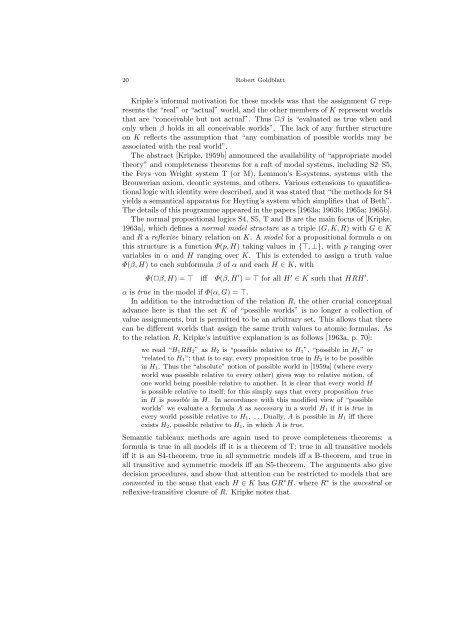MATHEMATICAL MODAL LOGIC: A VIEW OF ITS EVOLUTION
MATHEMATICAL MODAL LOGIC: A VIEW OF ITS EVOLUTION
MATHEMATICAL MODAL LOGIC: A VIEW OF ITS EVOLUTION
You also want an ePaper? Increase the reach of your titles
YUMPU automatically turns print PDFs into web optimized ePapers that Google loves.
20 Robert GoldblattKripke’s informal motivation for these models was that the assignment G representsthe “real” or “actual” world, and the other members of K represent worldsthat are “conceivable but not actual”. Thus ✷β is “evaluated as true when andonly when β holds in all conceivable worlds”. The lack of any further structureon K reflects the assumption that “any combination of possible worlds may beassociated with the real world”.The abstract [Kripke, 1959b] announced the availability of “appropriate modeltheory” and completeness theorems for a raft of modal systems, including S2–S5,the Feys–von Wright system T (or M), Lemmon’s E-systems, systems with theBrouwerian axiom, deontic systems, and others. Various extensions to quantificationallogic with identity were described, and it was stated that “the methods for S4yields a semantical apparatus for Heyting’s system which simplifies that of Beth”.The details of this programme appeared in the papers [1963a; 1963b; 1965a; 1965b].The normal propositional logics S4, S5, T and B are the main focus of [Kripke,1963a], which defines a normal model structure as a triple (G, K, R) with G ∈ Kand R a reflexive binary relation on K. A model for a propositional formula α onthis structure is a function Φ(p, H) taking values in {⊤, ⊥}, with p ranging overvariables in α and H ranging over K. This is extended to assign a truth valueΦ(β, H) to each subformula β of α and each H ∈ K, withΦ(✷β, H) = ⊤ iff Φ(β, H ′ ) = ⊤ for all H ′ ∈ K such that HRH ′ .α is true in the model if Φ(α, G) = ⊤.In addition to the introduction of the relation R, the other crucial conceptualadvance here is that the set K of “possible worlds” is no longer a collection ofvalue assignments, but is permitted to be an arbitrary set. This allows that therecan be different worlds that assign the same truth values to atomic formulas. Asto the relation R, Kripke’s intuitive explanation is as follows [1963a, p. 70]:we read “H 1RH 2” as H 2 is “possible relative to H 1”, “possible in H 1” or“related to H 1”; that is to say, every proposition true in H 2 is to be possiblein H 1. Thus the “absolute” notion of possible world in [1959a] (where everyworld was possible relative to every other) gives way to relative notion, ofone world being possible relative to another. It is clear that every world His possible relative to itself; for this simply says that every proposition truein H is possible in H. In accordance with this modified view of “possibleworlds” we evaluate a formula A as necessary in a world H 1 if it is true inevery world possible relative to H 1. . . . Dually, A is possible in H 1 iff thereexists H 2, possible relative to H 1, in which A is true.Semantic tableaux methods are again used to prove completeness theorems: aformula is true in all models iff it is a theorem of T; true in all transitive modelsiff it is an S4-theorem, true in all symmetric models iff a B-theorem, and true inall transitive and symmetric models iff an S5-theorem. The arguments also givedecision procedures, and show that attention can be restricted to models that areconnected in the sense that each H ∈ K has GR ∗ H, where R ∗ is the ancestral orreflexive-transitive closure of R. Kripke notes that
















